The chemistry of nucleation
Abstract
Nucleation phenomena are of critical importance in numerous areas of science and everyday life. For decades the prevailing models to explain nucleation have been based on thermodynamic arguments without consideration of the chemical nature of the specific system. Even though newer models have included system-dependent variables, the quantitative atomistic differences are largely ignored. As a consequence, nucleation processes are treated on a “particle” or “monomer” level without discussion of the true atomic scale “chemistry of nucleation”. In the past couple of years, in situ studies of solvothermal reactions have considerably changed the experimental insight into nucleation phenomena, and especially the measurement of X-ray total scattering data and the subsequent pair distribution function analysis have proven to be vital tools. Here we discuss in situ results obtained for ten different material systems, and show that nucleation of nanoparticles in solvothermal reactions expose a fascinating chemical richness spanning from mono-metal to complex polymer precursor species, which, through a specific system-dependent multistep reaction mechanism, develop into pristine nanocrystals. It is argued that it is time to introduce a paradigm shift in the general nucleation theory and move away from the “one model fits all” to a chemistry-based approach rooted in atomic scale insight.



 Please wait while we load your content...
Please wait while we load your content...